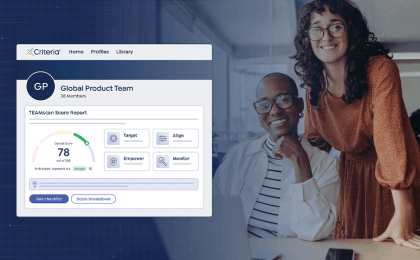Employee performance is one of the most important metrics for success, especially when evaluating the effectiveness of your hiring process. With every hire you make, your goal is to select the candidate who is the most likely to succeed in their role. In order to evaluate how well your hiring process is achieving that goal, it’s important to have a process in place to measure employee performance once they get hired. These metrics can then inform the tactics you use to improve that metric.
How do you measure employee performance?
Evaluating how well an employee performs may seem extremely subjective, and in a lot of ways it is. But without quantifying employee performance, it becomes impossible to measure how well you’re doing as an organization, and it’s equally challenging to identify whether performance is going up or down over time.
There are many ways to evaluate employee performance depending on your company’s industry and overall goals. For example, manufacturing companies might measure performance on an output basis by measuring the amount of widgets being produced. A customer service-oriented company might measure performance through customer satisfaction ratings. Sales teams might measure performance primarily through sales numbers.
However, one employee performance measurement that is relatively universal to any company is performance ratings. In most cases employee performance ratings can be assigned by the employee’s manager, or it could be a combination of ratings from multiple supervisors and peers. Typical ratings are often based on a scale of 1 to 5, or 1 to 10. Whatever the details of how an individual rating is calculated, the power of the performance rating is that it provides a quantifiable number that you can use to not only compare employees but also to use as a company average that can be tracked over time.
For example, let’s say the average performance rating in your department in one year is 3.3 out of 5. And let’s say your goal in the following year is to raise that number by adopting a few tactics in the hiring process to bring in stronger talent. In the following year, you might find that your average performance rating has gone up to 3.8, a number that may seem small until you realize that the average went up 15% within a single year – a major win for any organization.
How to Improve Employee Performance
As we suggested earlier, employee performance isn’t just one thing, and it can be measured in many different ways. In fact, it’s likely that your organization chooses to measure employee performance across multiple different metrics. As long as you are consistent with how you measure it, it should be relatively easy to see how it changes from one year to the next. The question is, how do you move the needle in a positive direction?
Employee performance is the result of many organizational factors, but it’s also impacted by the candidates you’re bringing in at the hiring level. For example, improving your general quality of hire can significantly improve employee performance in your organization. By adopting hiring tactics that help you improve your quality of hire, you can start to see positive changes.
One way to start is by incorporating more data driven hiring factors that are better at predicting job performance. Pre-employment tests, for example, are one of the most predictive hiring factors. Cognitive aptitude tests in particular are far more predictive of job performance than unstructured interviews and resumes. By administering pre-employment tests in the hiring process, employers can gain data-driven insight into their candidates that help them make more informed hiring decisions.
Take one company that used pre-employment tests to not only dramatically reduce turnover but also led to a 15% increase in performance ratings from one year to the next. Another company used pre-employment tests to improve their hiring success rate by 26%, as measured by employee performance ratings. Yet another company found that pre-employment test scores were highly correlated with employee performance ratings - they found that, on average, employees who passed a personality test achieved 30% higher performance ratings than those who did not pass the test.
The correlation component is key. Because pre-employment tests are significantly correlated with job performance, using tests in the hiring process translates into tangible and dramatic improvements in employee performance. However you choose to measure employee performance year to year, measuring it consistently enables you to identify if it needs improvement, and it also helps you demonstrate when your efforts are working.





